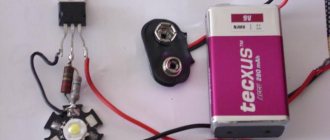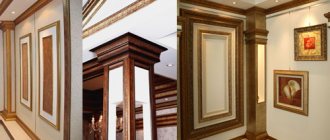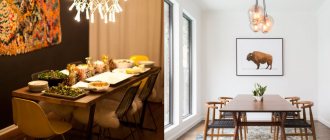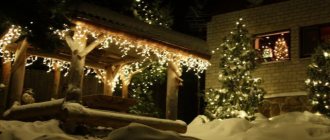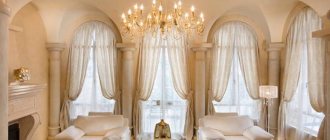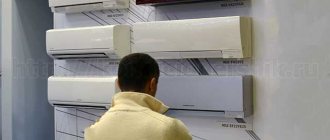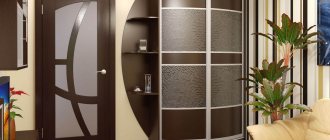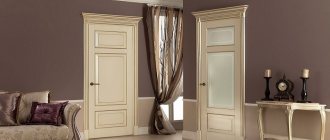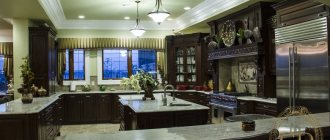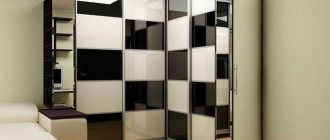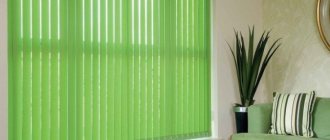Main types and functions of backlight
Mirror illumination performs the function of a clear reflection and acts as a decorative element.
Mirror illumination is designed for uniform natural illumination of a person’s silhouette, eliminating shadow effects that hide makeup defects and imperfections in clothing. Lighting also serves as decoration for the interior of the room.
The following types of lighting are installed on mirrors:
- The external layout is made up of lamps located around the perimeter on the body, frame or wall.
- Built-in lighting is equipped by installing LED strips under the glass along the perimeter of the outer edge of the canvas, removing part of the reflective coating.
- Decorative lighting is used for the stylistic, original design of a room.
Decorative lighting was identified as a separate type according to the task of design decoration performed. Its layout can also be built-in or external.
How to combine Feng Shui in normal life
Every rule has exceptions, and in Chinese teaching you can find a golden mean for placing a mirror in the bedroom. Look at the photo of mirrors in the bedroom for the correct placement.
The main thing is to ensure that the reflection of a sleeping person does not fall into the mirror. That is, you can safely put a dressing table in the bedroom with a mirror or hang a mirror on the wall. But remember: while in bed, you should not see your reflection, so you can forget about the mirror ceiling in the bedroom.
Many of us have a wardrobe with a mirror in the bedroom, what should we do? If it is not possible to move the cabinet to another place, then you need to stop multiplying the Qi energy and just hang it up for the night.
Psychologists believe that upon waking up and seeing one’s reflection, a person can get scared and go into a state of shock.
Features and Benefits
Illumination devices produce bright, diffused light, directing it not at the surface of the mirror, but at the space in front of it. The number and location of light sources are determined taking into account the characteristics of the room and the purpose of the mirror.
The use of local mirror illumination provides the following advantages:
- Light elements are distributed along the perimeter of the reflective sheet, illuminating the space in front of it evenly.
- Strict directionality of light sources eliminates glare.
- The lamps sum up the luminous flux and produce bright light.
- Lighting devices with natural color rendering provide an analogue of daylight.
- Frosted diffusers eliminate glare effects.
A backlit mirror does not distort the reflection with shadows or unnatural shades, but shows the real appearance of a person.
Advantages and disadvantages
Since ancient times, the mirror has been an integral part of magical rituals and fortune-telling, transporting a person to an otherworldly mysterious world. To this day, many people adhere to the established signs:
- in connection with the death of a person, all mirror surfaces are covered with cloth;
- You cannot bring a baby or child to the reflection;
- ancient beliefs prohibit eating while looking at your reflection;
- It is not recommended to sleep in front of a mirror, so it should not be placed in front of the sleeping area.
Household members who believe in folk omens place a dressing table with a mirror for the bedroom so that the body is not reflected in it during sleep. There is an option to cover it at night with a beautiful decorative curtain.
Types of lamps
Fluorescent lamp for mirrors
The type of light sources for illumination determines its reliability, functionality, and efficiency. The dimensions of lighting fixtures are important for the design of the room.
Mirror lighting is made from the following types of light sources:
- Incandescent lamps have an affordable price, a large selection of sizes and wattages, but a short service life. The light from such sources has a reddish tint, which does not provide natural lighting, distorting the real image of a person in reflection. High values of energy consumption and operating temperature lead to the limited applicability of such lamps for illuminating mirrors.
- Halogen lamps have a more natural glow, but are not economical. They heat up to 500℃, which leads to premature failure.
- Luminescent sources have a natural spectrum, economical energy consumption, and a long service life. Linear luminaires and compact fluorescent lamps are used for outdoor lighting, since their dimensions limit the possibility of being built inside a mirror body.
- Neon tubes are used for colored decoration. The peak of neon's popularity was in the eighties of the last century. The advent of inexpensive, convenient semiconductor lighting sources has led to a decline in demand for neon.
- LED strips and lamps are more economical and durable than fluorescent devices. LED sources are environmentally friendly, safe for health, and create bright lighting with color rendition close to the solar spectrum. The compact dimensions of LED strips make it possible to produce built-in mirror lighting.
LED lamps do not heat up during operation, which allows them to be used to illuminate dressing room mirrors.
LED lighting fixtures
LED lamp
The use of ready-made LED lamps is gaining popularity in various areas of everyday life. The variety of shapes, sizes, modifications provides scope for creativity of designers.
They use overhead, built-in, and hanging LED lamps for mirrors. If there is no electrical wiring, use stand-alone battery-powered models. Skilled craftsmen independently produce various options for lighting from LED elements.
Color shades of lamps
Lighting sources are characterized by color rendering, which imposes a shade of a certain color range. In everyday life, lamps with cold, white, and warm spectrums are used.
Cool light creates a clear, detailed reflection, but strains the eyes. Warm light is pleasant to the eye, creates a cozy atmosphere, but distorts the color of the reflection with red tints. Balanced white light allows you to achieve natural illumination of the face, creating a real reflection.
Concept of color temperature
First, it’s worth understanding better how a cold color differs from a warm color. It's actually simple:
- Warm light. Color temperature from 2700 to 3500 Kelvin. Beneath it lies a natural luminous flux for the eye, similar to that emanating from the sun. It promotes relaxation, but reduces performance and concentration, so it is used in living rooms for relaxation.
- Cold light. Color temperature from 5000 to 6000 Kelvin. It is a bluish-white color suitable for mobilization and concentration, which increases performance. However, prolonged exposure to cold light reduces productivity by more than 25% over time.
There is also neutral light with a color temperature of 4000 to 4500 Kelvin, which also includes natural sunlight. This light does not cause fatigue and does not have a bad effect on the psyche. In essence, it is a compromise solution between cold and warm light, and is used quite often.
Accommodation options
Built-in mirror lighting around the perimeter
The location of the light sources affects the uniformity of lighting. Lamps for external lighting are placed on the sides of the canvas, top, bottom or along the perimeter of the frame. Installing lamps around the perimeter is used for makeup mirrors, since this arrangement allows you to illuminate all areas of the face in detail.
The illumination of tall mirrors in hallways and corridors is made from six or more sources, evenly distributed along the sides. A smaller number of sources does not provide bright illumination in height.
The built-in lighting is made of LED strips, which are mounted on the back side of the canvas along the perimeter edge. The reflective coating is removed from the LED installation line, and the resulting transparent windows are covered with a matte film.
For decorative lighting equipment, white and colored RGB LED strips are used, which are embedded under a reflective sheet or mounted externally on a frame or glass. 3D designs of two parallel reflectors with an LED strip located along the contour between them are popular.
Switch types
The lamps are powered from a 220 V network, and the LED strips operate from a constant voltage of 12 V, generated by an additional power supply. The circuit is connected to the electrical network using push-button, touch, or remote switches.
Stationary buttons are installed on the body in an accessible place, but not conspicuous. The backlight with switchable color modes is equipped with remote control. Modern elements make it possible to equip an electronic circuit with a motion sensor or voice control.
How to choose backlight
Dressing room mirror with light bulbs
The lighting of the mirror is ordered by a master, made independently, or purchased as a finished product. When choosing a ready-made option, take into account the interior style of the room and compatibility with pieces of furniture.
The functionality and aesthetics of the backlight are determined by the following parameters:
- The dimensions and purpose of the mirror determine the number and location of light sources. A tall canvas requires multi-level lighting, but for a compact one it is enough to place two lamps on the sides. The exception is dressing room and makeup mirrors, the lighting of which consists of ten or more lamps evenly distributed over the frame.
- The complete set of the mirror includes additional accessories, shelves, built-in drawers, cabinets that require local lighting.
- Materials for manufacturing the frame body, types of lighting fixtures. Plastic and metal frames are the most functional, as they are not exposed to the external environment. Wooden structures have an aesthetic appearance, but they dry out or absorb moisture. The production of such frames requires adherence to technology. Incandescent lamps are incompatible with wood, as they heat up to high temperatures, drying out the material.
Design safety is a decisive selection criterion. Open socket mounts, protruding contacts, and protruding wires are not allowed.
Photo of a mirror in the bedroom
Note! Upholstered bedroom - 100 photos of the best ideas for upholstered furniture for the bedroom
Let's discuss this article together:
Click to cancel reply.
Design and appearance
Lighting fixtures and the shape of accessories are selected based on the interior features of the room. Mirrors of regular geometric shapes are suitable for modern design, and carved canvases are compatible with the classic style.
External lighting is mounted on a massive frame, the shape and color of which influence the appearance of the room. Transparent lamps are covered with diffuser shades. LED lamps with a matte bulb have an aesthetic appearance, which allows them to be used without special caps.
The built-in lighting is decorated with carved windows in a reflective coating, through which light enters. The reflective layer is carefully cut in the form of drawings, patterns, and ornaments.
DIY installation and connection
If the frame is wooden, you need to choose lamps that do not heat up.
For example, we will consider the process of manufacturing the external lighting of a 50x70 cm makeup mirror on a wooden frame from sixteen LED lamps with a standard E27 base, operating voltage 220 V. Lamps with frosted caps will be used, luminous flux 280 lm, power consumption 3.5 W. Assembly will require 16 ceramic cartridges, a cable, a push-button switch, a wooden block, plywood, metal corners, self-tapping screws, and PVA glue.
Step-by-step work plan:
- Making the frame. Sawing the block into 4 parts with the lengths of the sides of the mirror and cutting angles of 45˚. Frame assembly, gluing, fixing with corners.
- Marking, drilling holes with a diameter of 35 mm for cartridges. For the upper and lower trims, step back 5 cm from the corner of the frame, drill 5 holes every 15 cm, observing the axis of symmetry. For side trims, the outer holes are placed 10 cm from the corners, as well as one hole in the middle. The result is 5 grooves on the horizontal sides of the frame, and 3 grooves on the vertical parts.
- Processing the baguette with sandpaper.
- Installation of cartridges, fastening with glue, corners, screws, parallel connection to an electrical cable with a switch and plug.
- Painting the baguette, varnishing or staining.
- Installation of mirror sheet.
- Securing the plywood back cover.
- Installing lamps, checking the network connection.
This design produces uniform illumination with a total luminous flux of 4480 lm, consumes 56 W of power, and does not heat up. Hidden installation of cartridges guarantees safe operation.
Equipping a metal baguette with electrical wiring with a voltage of 220 V requires compliance with safety rules. The frame body is grounded, and the cable is placed in insulated channels or corrugation.

